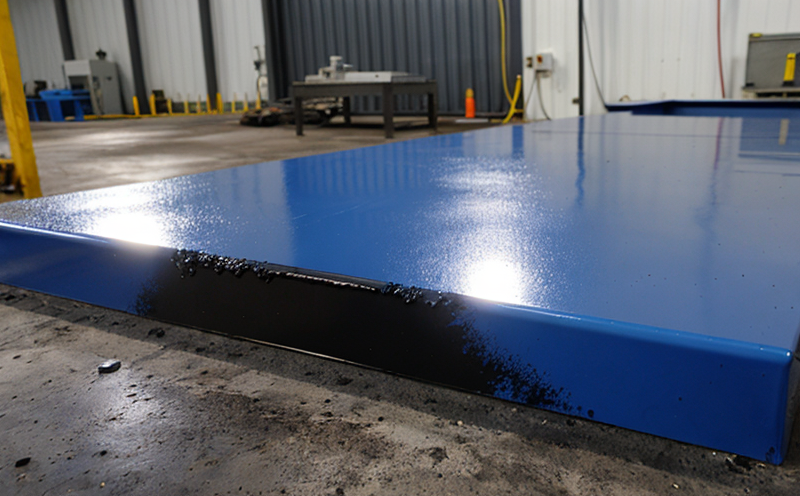ISO 2409 Cross-Cut Adhesion Testing
The ISO 2409 Cross-Cut Adhesion Test is a widely recognized method used to evaluate the adhesion strength of surface coatings, platings, and treatments. This test assesses how well a coating bonds to the underlying substrate by creating small cuts across the coated surface and measuring the resistance to separation.
This standardized procedure ensures that materials meet specific performance criteria, which is critical for industries reliant on durable finishes such as automotive, aerospace, electronics, and construction. By employing this test method, manufacturers can verify the robustness of their coating systems under real-world conditions where environmental stress might compromise adhesion.
The process involves applying a coating to a substrate according to specified parameters. After drying or curing, a cross-cut pattern is etched into the surface using a sharp instrument like a scalpel. The depth and spacing between cuts are critical; they must adhere strictly to ISO 2409 standards for accurate results.
Once prepared, samples undergo environmental conditioning if necessary before being subjected to an adhesive tape test. During this phase, adhesive tape is applied over the cross-cut area, allowed to bond with the coating, and then quickly removed in one swift motion. The degree of adhesion failure provides insights into the cohesive strength of the coating system.
The primary outcome of ISO 2409 testing is a visual assessment of the extent of adhesion failure along each cut line. This information helps engineers understand which areas may require improvement, ensuring that coatings perform consistently across different substrates and applications.
For precise and reliable results, it's essential to follow all steps meticulously as outlined in ISO 2409:1998 or its subsequent amendments. Any deviation could lead to inaccurate conclusions about the coating’s adhesion properties.
The test is particularly useful for quality assurance teams who must ensure compliance with industry standards while also optimizing product performance through iterative testing and refinement processes.
- Specimen Preparation: Careful selection of materials to simulate realistic use conditions.
- Cutting Pattern: Specific patterns defined in ISO 2409 guide the etching process accurately.
- Adhesive Tape Application: Methodology ensures consistent force application during testing.
The ISO 2409 Cross-Cut Adhesion Test plays a pivotal role in maintaining high-quality standards within various sectors. Its rigorous methodology guarantees that any adherence issues are identified early in the development cycle, allowing for timely corrective actions to be implemented.
Eurolab Advantages
At Eurolab, our commitment to excellence sets us apart when it comes to conducting ISO 2409 Cross-Cut Adhesion Testing. Our state-of-the-art facilities and experienced technicians provide unparalleled accuracy and reliability in every test conducted.
- Accurate Equipment: Utilizing precision instruments tailored for this specific type of testing ensures consistent results across all samples.
- Comprehensive Reporting: Detailed reports are generated promptly after each test, providing valuable insights into the performance of coated materials.
- Expertise: Our team comprises highly qualified professionals with extensive experience in material science and engineering who understand the nuances of this testing technique.
We pride ourselves on delivering services that meet or exceed customer expectations. With Eurolab, you can rest assured knowing your samples are being handled by experts who know exactly what it takes to produce accurate results.
International Acceptance and Recognition
The ISO 2409 Cross-Cut Adhesion Test has gained widespread acceptance across numerous industries worldwide. Its broad applicability makes it a cornerstone in quality assurance programs for manufacturers looking to ensure the integrity of their products.
Many global standards bodies and regulatory agencies recommend or require compliance with this test method as part of their certification processes. For example, ISO 2409 is frequently cited by automotive OEMs and suppliers as part of their supplier evaluation criteria.
The use of standardized testing methods like ISO 2409 helps level the playing field among competing manufacturers. It ensures that all participants are working under consistent conditions, which fosters fair competition based on product quality rather than variability in test procedures.
Additionally, adherence to international standards such as these enhances brand reputation and market competitiveness by demonstrating a commitment to best practices within the industry.
Competitive Advantage and Market Impact
- Prompt Compliance: By staying ahead of regulatory requirements, companies can secure early market entry opportunities.
- Enhanced Reputation: Demonstrating adherence to rigorous testing protocols builds trust among consumers and partners alike.
- Innovation Leadership: Continuous improvement in testing methods drives innovation within the sector.
The ability to consistently meet or exceed ISO 2409 standards not only strengthens a company’s position but also opens doors for strategic partnerships and joint ventures. Moreover, successful implementation of this test method can lead to significant cost savings by identifying potential flaws early in the manufacturing process.
For businesses operating globally, compliance with international standards like ISO 2409 is increasingly seen as a strategic asset that contributes positively towards overall business growth and sustainability.





